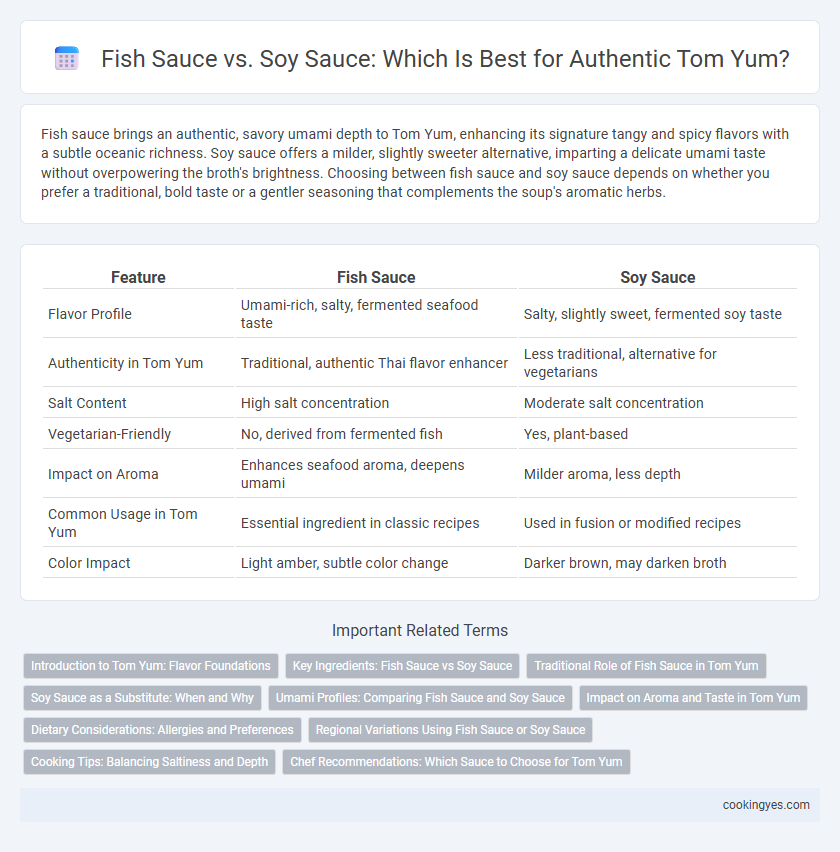Fish sauce brings an authentic, savory umami depth to Tom Yum, enhancing its signature tangy and spicy flavors with a subtle oceanic richness. Soy sauce offers a milder, slightly sweeter alternative, imparting a delicate umami taste without overpowering the broth's brightness. Choosing between fish sauce and soy sauce depends on whether you prefer a traditional, bold taste or a gentler seasoning that complements the soup's aromatic herbs.
Table of Comparison
| Feature | Fish Sauce | Soy Sauce |
|---|---|---|
| Flavor Profile | Umami-rich, salty, fermented seafood taste | Salty, slightly sweet, fermented soy taste |
| Authenticity in Tom Yum | Traditional, authentic Thai flavor enhancer | Less traditional, alternative for vegetarians |
| Salt Content | High salt concentration | Moderate salt concentration |
| Vegetarian-Friendly | No, derived from fermented fish | Yes, plant-based |
| Impact on Aroma | Enhances seafood aroma, deepens umami | Milder aroma, less depth |
| Common Usage in Tom Yum | Essential ingredient in classic recipes | Used in fusion or modified recipes |
| Color Impact | Light amber, subtle color change | Darker brown, may darken broth |
Introduction to Tom Yum: Flavor Foundations
Fish sauce and soy sauce play distinct roles in Tom Yum's flavor profile, with fish sauce providing the essential umami and salty depth crucial for the soup's authentic Thai character. Fish sauce, made from fermented fish, introduces a complex, savory aroma that enhances the broth's spicy and sour elements, while soy sauce, primarily derived from fermented soybeans, offers a milder, slightly sweet saltiness more common in other Asian cuisines. Choosing fish sauce over soy sauce preserves Tom Yum's traditional balance of bold, tangy, and savory notes, defining its signature taste.
Key Ingredients: Fish Sauce vs Soy Sauce
Fish sauce is a key ingredient in traditional Tom yum, providing a distinct umami flavor and salty depth essential for authentic Thai taste. Soy sauce, while sometimes used as a substitute, offers a milder, less complex savoriness that can alter the dish's characteristic profile. Choosing fish sauce preserves the vibrant, aromatic balance of Tom yum by enhancing its sour, spicy, and herbal notes.
Traditional Role of Fish Sauce in Tom Yum
Fish sauce plays a crucial traditional role in Tom Yum, providing a distinctive umami flavor that enhances the soup's complex balance of sour, spicy, and herbal notes. Unlike soy sauce, which is less common in authentic Tom Yum recipes, fish sauce contributes essential depth and saltiness integral to Southeast Asian culinary profiles. The use of fish sauce maintains the soup's characteristic taste, reflecting its origins in Thai cuisine and traditional preparation methods.
Soy Sauce as a Substitute: When and Why
Soy sauce can serve as a substitute for fish sauce in Tom yum when catering to vegetarian, vegan, or allergy-conscious diets, providing a salty umami flavor that complements the soup's spicy and sour profile. Although soy sauce lacks the distinct seafood aroma of fish sauce, it can enhance the broth's depth and maintain balance in the flavor composition. Use light soy sauce to avoid overpowering the dish, ensuring the characteristic Tom yum tanginess and heat remain prominent.
Umami Profiles: Comparing Fish Sauce and Soy Sauce
Fish sauce delivers a robust umami depth with its fermented anchovy base, intensifying Tom yum's savory and salty notes. Soy sauce contributes a milder, slightly sweeter umami, balancing the soup's spicy and sour flavors without overwhelming the broth. The choice between these sauces shapes the overall flavor complexity, with fish sauce enhancing traditional authenticity and soy sauce offering a subtle, vegetarian-friendly alternative.
Impact on Aroma and Taste in Tom Yum
Fish sauce imparts a distinctive umami depth and salty tang essential to authentic Tom yum, enhancing its aromatic complexity with subtle oceanic notes. Soy sauce offers a milder, slightly sweet umami character but may dilute the vibrant citrus and spicy aromas typical of Tom yum. Choosing fish sauce over soy sauce significantly preserves the traditional balance of tangy, spicy, and savory flavors that define Tom yum's signature aroma and taste.
Dietary Considerations: Allergies and Preferences
Fish sauce, a staple in traditional Tom yum, offers a rich umami flavor but contains shellfish allergens, posing risks for individuals with seafood allergies. Soy sauce provides a plant-based, allergen-friendly alternative suitable for vegetarians and those with shellfish sensitivities, although it may alter the dish's authentic taste profile. Selecting between fish sauce and soy sauce depends on dietary restrictions and preference for maintaining traditional flavor versus allergen safety.
Regional Variations Using Fish Sauce or Soy Sauce
Tom yum traditionally uses fish sauce to achieve its characteristic umami and salty depth, especially in central and southern Thailand where fresh seafood is abundant. In northern Thailand and some regional variations, soy sauce may be incorporated to adjust the flavor profile, providing a slightly sweeter and milder taste. These regional differences highlight how local ingredient availability and culinary preferences influence the balance between fish sauce and soy sauce in authentic tom yum recipes.
Cooking Tips: Balancing Saltiness and Depth
Fish sauce provides authentic umami and a natural depth to Tom yum, enhancing its signature savory and salty profile with fermented anchovy flavors. Soy sauce, while less traditional, offers a milder saltiness and a subtle sweetness that can soften the dish's sharpness. Balancing these sauces requires careful tasting; start with fish sauce for saltiness and depth, then add a small amount of soy sauce to round out flavors without overpowering the hot and sour notes.
Chef Recommendations: Which Sauce to Choose for Tom Yum
Chef recommendations for Tom Yum consistently favor fish sauce over soy sauce due to its authentic, umami-rich flavor that enhances the soup's signature sour and spicy profile. Fish sauce, made from fermented anchovies, provides a depth and saltiness that soy sauce, typically sweeter and less pungent, cannot replicate in traditional Thai recipes. To achieve the genuine taste of Tom Yum, most culinary experts advise using high-quality fish sauce as the key seasoning ingredient.
Fish Sauce vs Soy Sauce for Tom yum Infographic

 cookingyes.com
cookingyes.com